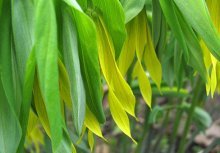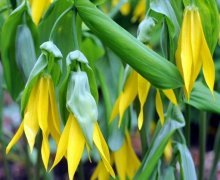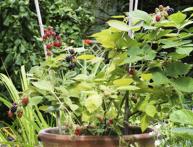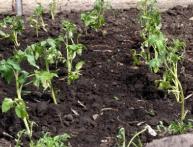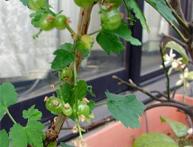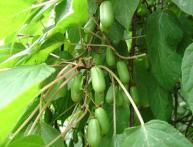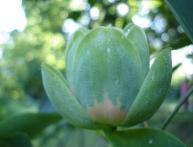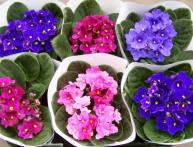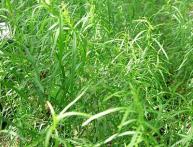Uvularia - an overseas beauty from the shadows
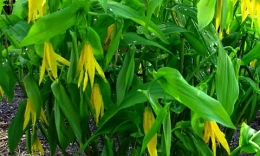
Local areas, gardens, and parks have many heavily shaded areas. This is due to the location of the site or the fact that buildings, large bushes, and trees cast shadows around them. When landscaping poorly sunny areas, shade-tolerant ornamental plants are required. This is where North American uvularia comes to the rescue.
Content:
Origin and description
Uvularia came to gardens from North America, where it grows from Canada to Mexico. A perennial herbaceous plant related to lilies. The rhizome branches horizontally and produces several straight stems. The height of the bush is up to 80 cm, the diameter is up to 40 cm. The flowers are quite large, drooping, cream or yellow-colored, reminiscent of lilies.
In nature it is represented by the following species:
- Uvularia grandiflora
- Uvularia pierced-leaved
- Uvularia sessile
- Uvularia florida
- Uvularia slightly pubescent
Uvularia blooms at the end of May. The fruit is a capsule. Seeds are surrounded an attractive nutritional shell for ants - elaisoma. Ants bring seeds with elaisoma to the larvae, and after they eat it, they take the seeds out of the nest, helping the uvularia to spread over large areas. The plant is frost-resistant, unpretentious.
Uvularia in the garden
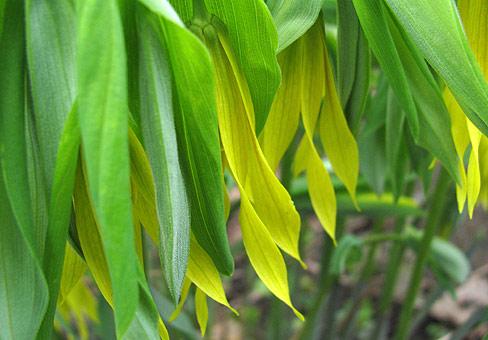
The plant appeared on the territory of Russia and the CIS countries relatively recently: in the late nineties of the last century. It remained quite rare for a long time.Currently, uvularia grandiflora (large-flowered) is most often cultivated. The plant does well under the shelter of garden trees, in areas with limited sunlight. This is due to the fact that in nature it prefers broad-leaved forests.
It grows quite slowly; when planted with seeds, it blooms in the fourth or fifth year of life. Powerful bushes, from several straight stems. The leaves are slightly pubescent, numerous. Flowering begins in May. Lasts 20 - 25 days. The flowers are green-yellow or yellow, in the shape of drooping bells, up to five centimeters long.
When decorating shady garden and park paths, uvularia bushes with delicate leaves look excellent. When blooming, yellow flowers brighten the shadiest corner of the site. After flowering stops, the bush does not lose its attractiveness. Even in autumn, yellowing leaves add color to the garden.
When arranging a rockery, this plant will be very natural and aesthetically pleasing among the stones, next to the medium-sized forms of coniferous plants:
- thuja
- juniper
- cypress
- spruce pyramidal
Unusual combination with purple-leaved barberries will add personality to garden compositions, especially in autumn: the yellowing leaves of uvularia and red barberries will create the illusion of flowering. Goes well with hostas and ferns. If there is a pond in the garden, then uvularia is simply irreplaceable for decorating its banks.
Planting and care
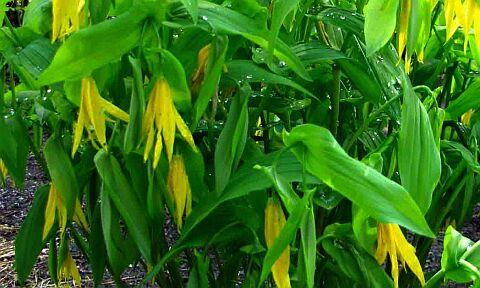
There are two ways to plant uvularia: by seeds and by dividing the bush. The soil is suitable for it of medium density, with an acidity close to neutral. Therefore, if necessary, add sand, clay, lime - fluff. It is better to plant freshly collected seeds in the fall, planting them to a depth of 5 cm.It is also possible to sow seeds in the spring: in a greenhouse or greenhouse. However, it should be remembered that flowering may have to wait at least five years.
You can achieve faster results dividing a large bush. To do this, at the end of summer, dig up the rhizome and cut it into several parts. It is important to ensure that all parts have a renewal bud. Treat the cut areas with ash. Place the separated part of the plant in a moistened planting hole, cover the rhizomes with soil, and lightly compact them. In order for the separated bushes to take root, you need to monitor the soil moisture and prevent it from drying out.
In spring and summer, plants need at least two feedings with mineral fertilizers and additional watering during drought.
Uvularia practically not damaged by diseases, but you should protect the tender leaves from being eaten by slugs and snails. This can be avoided by using special traps or by treating the plants with “Thunderstorm” and “Meta” preparations. Frost resistance is very good, but in snowless winters additional shelter is necessary.
Uvularia bushes feel great in one place for many years. The older the bush, the more beautiful it is. It is better not to touch it unless necessary, not to transplant it to another place and not to divide it. If you need additional bushes, it is best to purchase planting material from specialized flower shops, including through the Internet.
Video about the best ornamental greenery for your garden:
Interesting information about the vegetable garden

